#eadweardmuybridge
Photo

Eadweard Muybridge, Eadweard Muybridge, 1872, Smithsonian: National Portrait Gallery
Size: Image/Sheet: 51.5 x 39.1cm (20 1/4 x 15 3/8")
Medium: Albumen silver print
https://npg.si.edu/object/npg_NPG.2007.92
87 notes
·
View notes
Photo

Jockey Riding, Eadweard Muybridge, 1887, Harvard Art Museums: Photographs
Harvard Art Museums/Fogg Museum, Purchase through the generosity of Melvin R. Seiden
Size: 24 × 30.5 cm (9 7/16 × 12 in.)
https://www.harvardartmuseums.org/collections/object/284982
27 notes
·
View notes
Photo

Mirror Lake, Valley of the Yosemite, Eadweard Muybridge, 1872, Metropolitan Museum of Art: Photography
David Hunter McAlpin Fund, 1966
Size: 42.8 x 54.3 cm (16 7/8 x 21 3/8 in. )
Medium: Albumen silver print from glass negative
https://www.metmuseum.org/art/collection/search/271123
37 notes
·
View notes
Photo


Horse Smith cantering, saddled with nude rider by Eadweard Muybridge (1887)
#cantering#horse#horsebackriding#eadweardmuybridge#1800s art#1800s aesthetic#antique photography#wikimedia commons#fromthewikimediacommons#public domain
9 notes
·
View notes
Text

‘Occident’. Like most teenage boys, I was obsessed with Victorian photographer Eadweard Muybridge. Not just with how he spelled Edward, but with his creation of sequential photographic images. Or cinema, as we now know it. Of course, he wasn’t actually trying to invent a way to make us scared of sharks. He was trying to win a huge cash prize by proving a horse had all four feet off the ground at one point when it galloped. It took him several years to get it right. He might have done it quicker but he took time out to shoot his wife’s lover in cold blood. Anyway, all's well that ends well, he had a good lawyer, got away with murder and collected the prize in 1878. The crucial photo from the full sequence was one like my wobbly drawing (done by dribbling ink through a nozzle). All four hooves are indeed off the ground. But when they are tucked under the body, not outstretched like a rocking horse. Yeah, Stubbs, feeling pretty silly now, aintcha? Muybridge inevitably went on to photograph naked people carrying bricks and buckets of water but that’s for another day. Just like my homicidal hero, I've been creating a sequence of these horses. So advance warning, there is more to come.
#EadweardMuybridge#cashprize#gettingawaywithmurder#horsesoffacebook#horsedrawing#mylittlepony#mustangsally#mustphonemum#inkdrawing#equine#champion#trigger#silver#bullseye#muffinthemule#muffinwillcomeofmuffin#smurfandturf#equineandcheeseparty#lifedrawing#robmacgillivray#artists on tumblr#art
4 notes
·
View notes
Photo

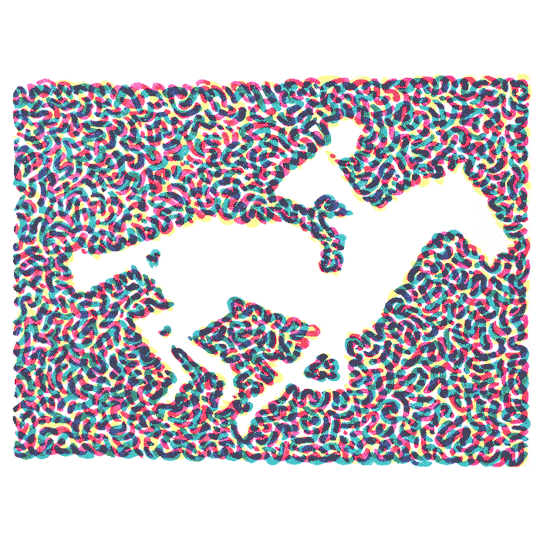

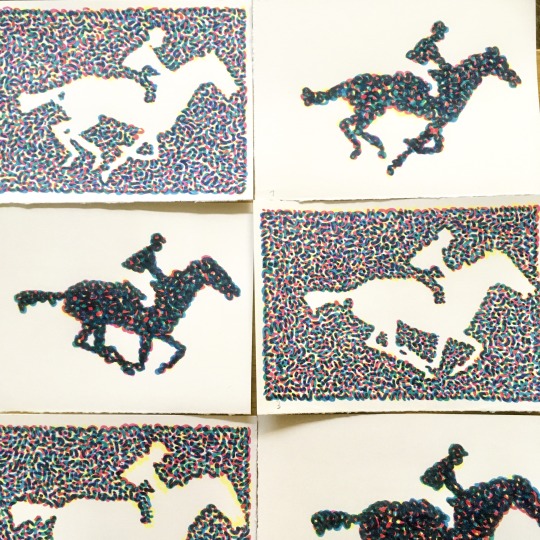
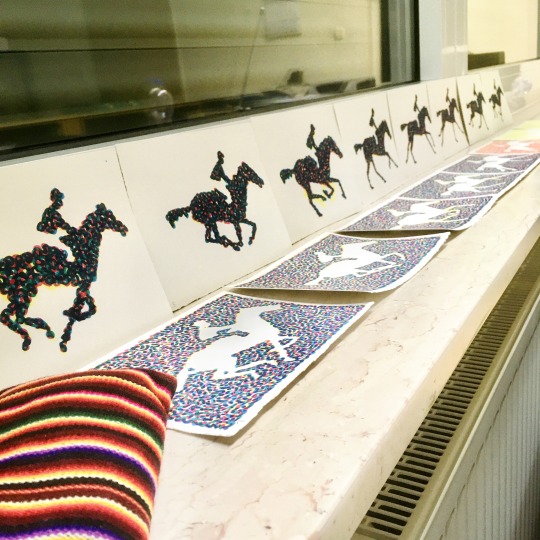
Two loops (and a cropin) based on Eadweard Muybridge’s The Horse In Motion from 1887 #sketchbook #doodle #abstract #cmyk #cmy #ecoline #ecolinebrushpen #eadweardmuybridge #thehorseinmotion #analog #handmade #animation https://www.instagram.com/p/CZUJRh2smKI/?utm_medium=tumblr
#sketchbook#doodle#abstract#cmyk#cmy#ecoline#ecolinebrushpen#eadweardmuybridge#thehorseinmotion#analog#handmade#animation
6 notes
·
View notes
Text
Eadweard Muybridge 1830-1904
“Only Photography has been able to divide Human Life into a series of moments, each of them has the value of a complete Existence” - Eadweard Muybridge
He was an eccentric inventor and photographer know for his pioneering work with motion and motion picture projection. He developed a miraculous process for capturing movement on film, laying the groundwork for the motion picture industry
1. 12-Frame Motion Picture of 2 Men boxing, from animal locomotion, Circa, 1887
2. Eadweard Muybridge: Figure Hopping series of photographs , 1887
3. Eadweard Muybridge Boys playing Leapfrog (1883–86, printed 1887), collotype


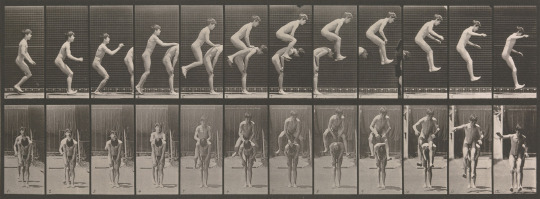
8 notes
·
View notes
Text
Cinematography’s forgotten inventor

Louis Le Prince was a French artist who worked in the USA and in Leeds, England. His father was good friends with Louis Deguerra, the inventor of the daguerreotype. Daguerre would teach Louis chemistry and photography. After graduating from University, Louis moved to Leeds, where his friend John Whiteley offered him a job. He later married John’s sister, Elizabeth, and started The Leeds Technical School of Art with her.
Later he met with Eadweard Muybridge, who had used 24 separate cameras to capture a horse in motion. Louise spent years experimenting with ways to achieve that effect with a single lens camera.
In 1888, Louis invented the single lens motion camera nicknamed “mark one”. He applied for a patent but was denied. Making some changes, he developed the “mark two”, and was successful at getting a patent. He tested the camera on October the 4th 1888 in the garden of Elizabeth’s parents, making the film Roundhay Garden.

Le Prince then shot Leeds Bridge.

He was meant to showcase his work at the Morris- Jumel mansion in NYC in September 1890. Louis visited his brother in Dijon, France first.
On 13th September his brother went to the train with him as he departed on his way home go to Leeds before setting off to New York. This was the last time Louis Le Prince was ever seen. His disappearance remains a mystery today.
A few months after Louis’s disappearance Thomas Edison successfully patented an almost exact copy of Le Prince’s mark two camera.
#louis le prince#cinematography#firstfilm#252wordbiography#eadweardmuybridge#international creativity month#1888#history#historyblr#historicalfigures#biography#short biography#shortbio#thomasedison#(1)
45 notes
·
View notes
Photo
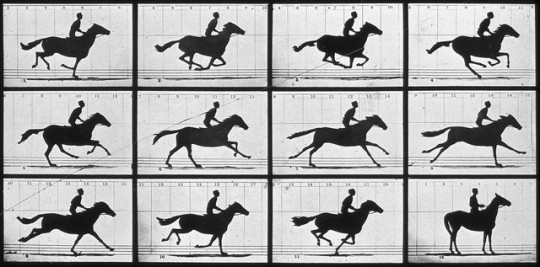
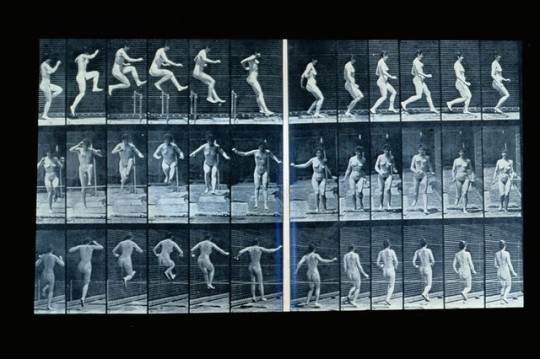
Happy Birthday to Eadweard Muybridge who was born on this day in 1830.
His pioneering work in photographic studies in motion and motion-picture projection was very important to many artists and was regarded as the foundation of modern cinema.
Animals in Motion
Muybridge, Eadweard, 1830-1904, American, English [artist]
1887
chronophotography
American
HOLLIS Number: olvwork242307
Human figures in motion: Woman jumping over low hurdle
1885
black and white photography
HOLLIS Number: olvwork242309
#eadweardmuybridge#BOTD#BornOnThisDay#photographer#chronophotography#blackandwhitephotography#photography#photographicstudies#fineartslibrary#harvardfineartslibrary#harvardfineartslib#Harvard#harvard library#library
13 notes
·
View notes
Text

A tiny tribute to Eadweard Muybridge, a photographer who, in the process of discovering whether or not a racehorse’s hooves leave the ground entirely while galloping, came up with a method of capturing and playing consecutive sequences of images that eventually (along with some other folks’ contributions) developed into film. This is Frame 2 of that study. Wikipedia has a nice history of his life as well as some examples of his work. Recommended!
2 notes
·
View notes
Photo

Eadweard Muybridge, Eadweard Muybridge, 1872, Smithsonian: National Portrait Gallery
Size: Image/Sheet: 51.5 x 39.1cm (20 1/4 x 15 3/8")
Medium: Albumen silver print
https://npg.si.edu/object/npg_NPG.2007.92
1 note
·
View note
Photo
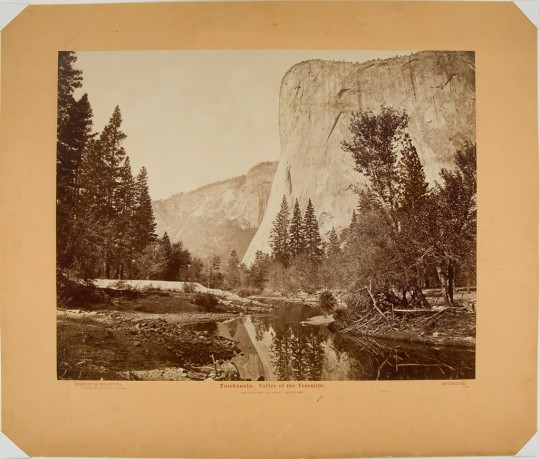
Tutokanula, Valley of the Yosemite, Eadweard Muybridge, 1870s, Harvard Art Museums: Photographs
Harvard Art Museums/Fogg Museum, Transfer from the Carpenter Center for the Visual Arts, Transferred from the Museum of Comparative Zoology
Size: 43.2 x 54.8 cm (17 x 21 9/16 in.) mount: 59.6 x 70.5 cm (23 7/16 x 27 3/4 in.)
https://www.harvardartmuseums.org/collections/object/157680
6 notes
·
View notes
Photo

[Woman Opening Parasol], Eadweard Muybridge, 1883–86, printed 1887, Metropolitan Museum of Art: Photography
Gift of the Philadelphia Commercial Museum, 1938
Medium: Collotype
https://www.metmuseum.org/art/collection/search/268623
16 notes
·
View notes
Photo

Harold Edgerton (American, 1903-1990) Rising Dove, 1934 This image was taken at 1/100,000th of a second. Bird flight was a particular subject of study for Edgerton as it had been for pioneer photographers of animal locomotion in the 19th century such as Eadweard Muybridge. Text: photoweb.com #Muybridge #EadweardMuybridge #flight #dove #rising #haroldedgerton #unusual #bird #birdsofinstagram #birdslovers #birds_captures #birdsphotography #noiretblancphotographie #blackandwhite #blackandwhitephotography #blackandwhitephoto #blackandwhitepic #bnw #bw #bnwphotography #photography #photographylovers #movement https://www.instagram.com/p/CR4EdAZLwUg/?utm_medium=tumblr
#muybridge#eadweardmuybridge#flight#dove#rising#haroldedgerton#unusual#bird#birdsofinstagram#birdslovers#birds_captures#birdsphotography#noiretblancphotographie#blackandwhite#blackandwhitephotography#blackandwhitephoto#blackandwhitepic#bnw#bw#bnwphotography#photography#photographylovers#movement
1 note
·
View note
Photo

‘Miss Cox (Nude – Arising from the Ground)’ is a many-sided artistic translation of artist Mariken Wessels’ fascination for an anonymous woman who had posed for Eadweard Muybridge’s camera in 1885. In the 24-image sequence ‘Arising from the Ground’ (plate 286) the obese woman, who was supposedly named Miss Cox, can be traced from lying down to a full upright position. Affected by her appearance, Wessels began to make large clay sculptures and to photograph obese female models swimming underwater. In these photographs Wessels focuses on the landscapes which a body assumes impressed by water. Besides the underwater series and photographic views of the sculptures, ‘Miss Cox’ also contains studio views including sketches and other research materials. Miss Cox, by @marikenwessels published by @fw.books Available online, link in bio #misscox #3ssbookselect #marikenwessels #fwbooks #eadweardmuybridge #model20 #3ssstudios #3standardstoppage (at New York, New York) https://www.instagram.com/p/CMdDuU2l12U/?igshid=kgx4w5x5spnf
#misscox#3ssbookselect#marikenwessels#fwbooks#eadweardmuybridge#model20#3ssstudios#3standardstoppage
0 notes
Photo

Animal Locomotion. An Electro-Photographic Investigation of Consecutive Phases of Animal Movements. Commenced 1872 - Completed 1885. Volume IV, Women (Nude) by Eadweard Muybridge, The Met's Photography Department
Medium: Photogravures
Rogers Fund, transferred from the Library Metropolitan Museum of Art, New York, NY
http://www.metmuseum.org/art/collection/search/266434
1 note
·
View note